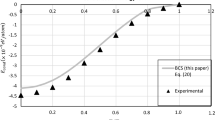Abstract
An ab initio analysis is made of the localized (in Mott’s sense) and delocalized (band) states of an electron in a crystal. The criterion of a difference between these states is the behavior of the off-diagonal elements in the one-particle electronic density matrix \(\left\langle {\hat \psi ^ + (r)\hat \psi (r')} \right\rangle\) for T=0. Localization can be related to its exponential falloff for |r−r′|→∞, and delocalization, to its power-law decay. This corresponds to the analyticity of the density matrix in k space of the Brillouin zone in the first case, and to a singularity (Fermi step) in the second. This analyticity gives rise also to a power-law decay of the correlation functions. In a normal system, localization can be identified with the insulating state, and delocalization, with the conducting state. It is shown that the above localization criterion is applicable to disordered systems as well. Electron localization in superconductors is also discussed. It is pointed out that the above criterion of localization is met also in the BCS superconducting state and in the localized-pair model. The reason for the considerable difference between the properties of the insulating and superconducting states lies in that there are no static fluctuations in the number of electrons, 〈(ΔN)2〉0, in the ground state of an insulator whereas in a superconductor ODLRO results in nonzero fluctuations of N of a quantum nature.
Similar content being viewed by others
References
N. F. Mott, Metal-Insulator Transition (Taylor & Francis, 1990).
N. F. Mott, Philos. Mag. 6, 287 (1961).
S. P. Shubin and S. V. Vonsovskii, Proc. R. Soc. London, Ser. A 445, 149 (1934).
N. N. Bogolyubov, Lectures on Quantum Statistics, Selected Works, Vol. 2 [in Russian] (Naukova Dumka, Kiev, 1971).
J. B. Goodenough, Magnetism and the Chemical Bond (Wiley, New York, 1963).
J. C. Hubbard, Proc. R. Soc. London, Ser. A 276, 238 (1963); ibid. 277, 237 (1964); ibid.; 281, 401 (1964).
E. K. Kudinov, Fiz. Tverd. Tela (Leningrad) 33, 2306 (1991) [Sov. Phys. Solid State 33, 1299 (1991)].
R. Resta and S. Sorella, cond-mat/9808151.
E. J. Blount, Solid State Physics, Vol. 13 (Academic, New York, 1963).
N. N. Bogolyubov, Quasi-Means in Statistical Mechanics Problems, Selected Works, Vol. 2 [in Russian] (Naukova Dumka, Kiev, 1971).
J. M. Luttinger and J. C. Ward, Phys. Rev. 118, 1417 (1960).
P. W. Anderson, J. Phys. Chem. Solids 11, 26 (1962).
S. F. Edwards, Philos. Mag. 3, 1020 (1958).
E. K. Kudinov, Fiz. Tverd. Tela (Leningrad) 31, No. 6, 14 (1989) [Sov. Phys. Solid State 31, 922 (1989)].
A. S. Aleksandrov, Zh. Fiz. Khim. 57, 273 (1983).
Author information
Authors and Affiliations
Additional information
Fiz. Tverd. Tela (St. Petersburg) 41, 1582–1592 (September 1999)
Rights and permissions
About this article
Cite this article
Kudinov, E.K. The insulating and conducting crystal states. Localization and delocalization of electronic states. Phys. Solid State 41, 1450–1459 (1999). https://doi.org/10.1134/1.1131030
Received:
Issue Date:
DOI: https://doi.org/10.1134/1.1131030




